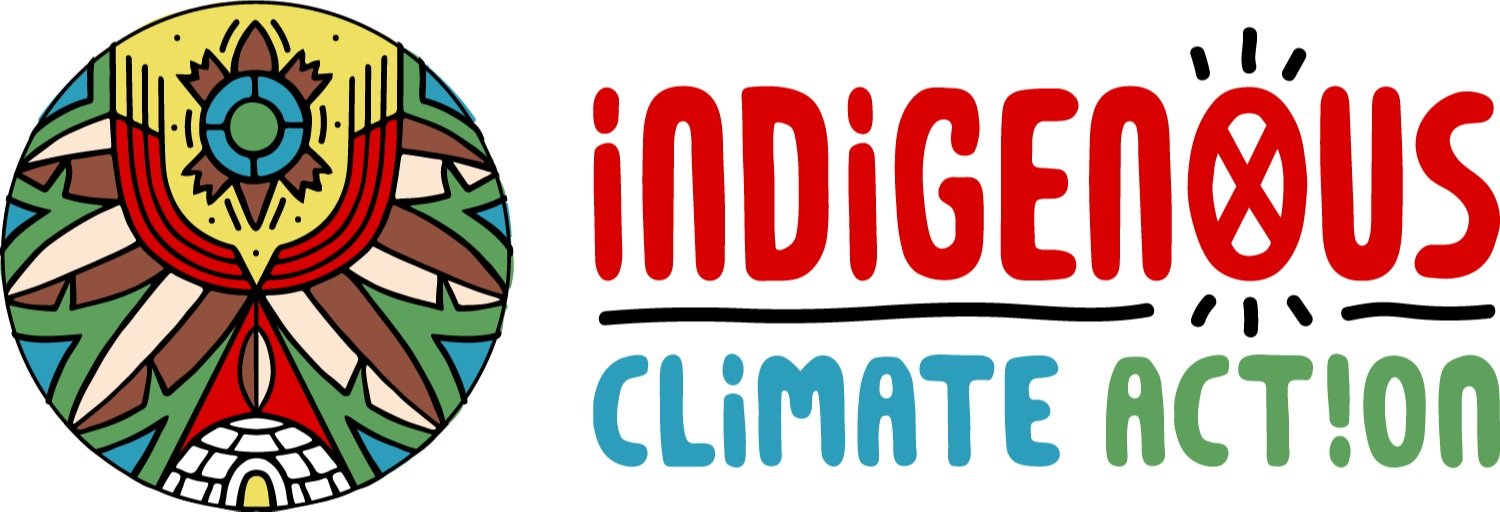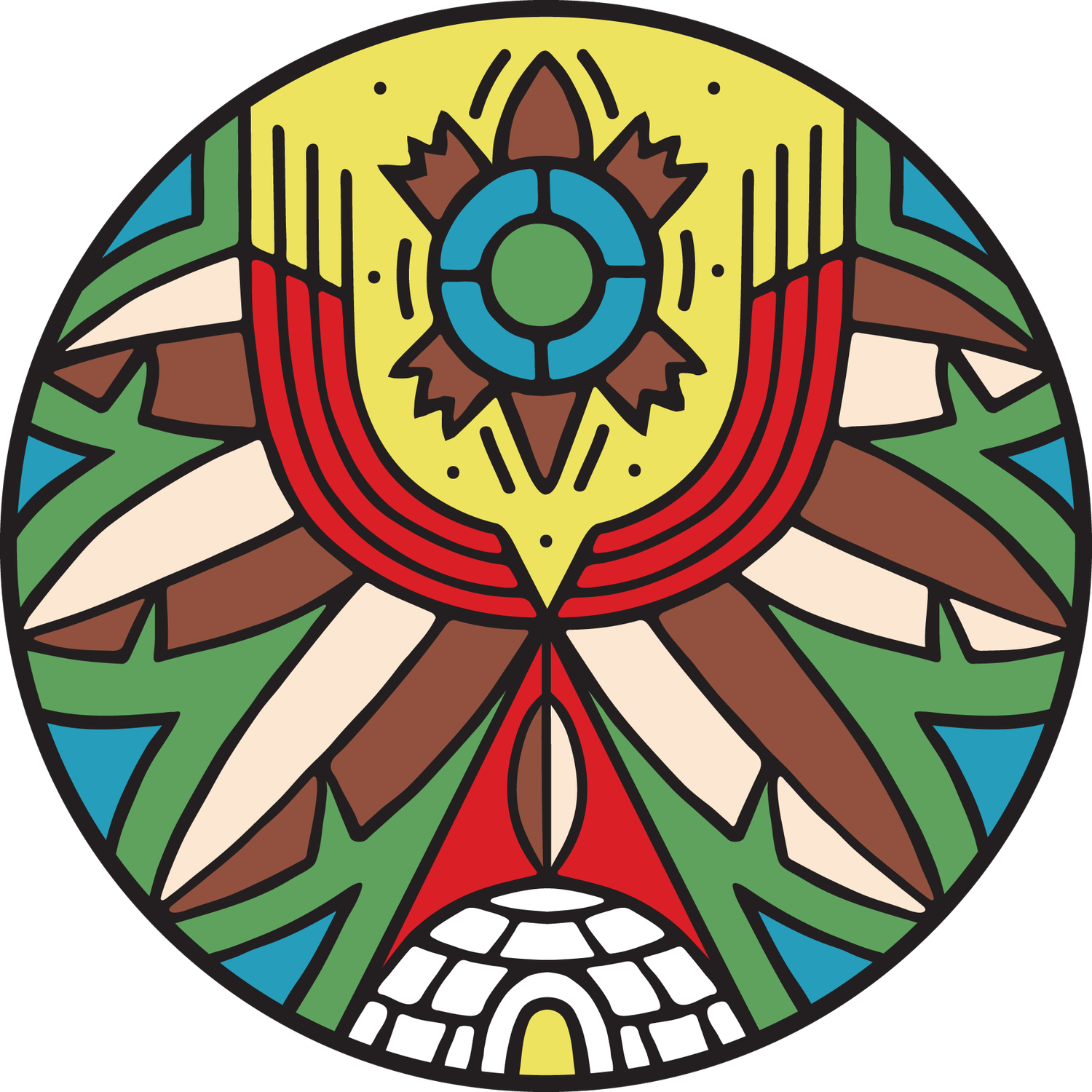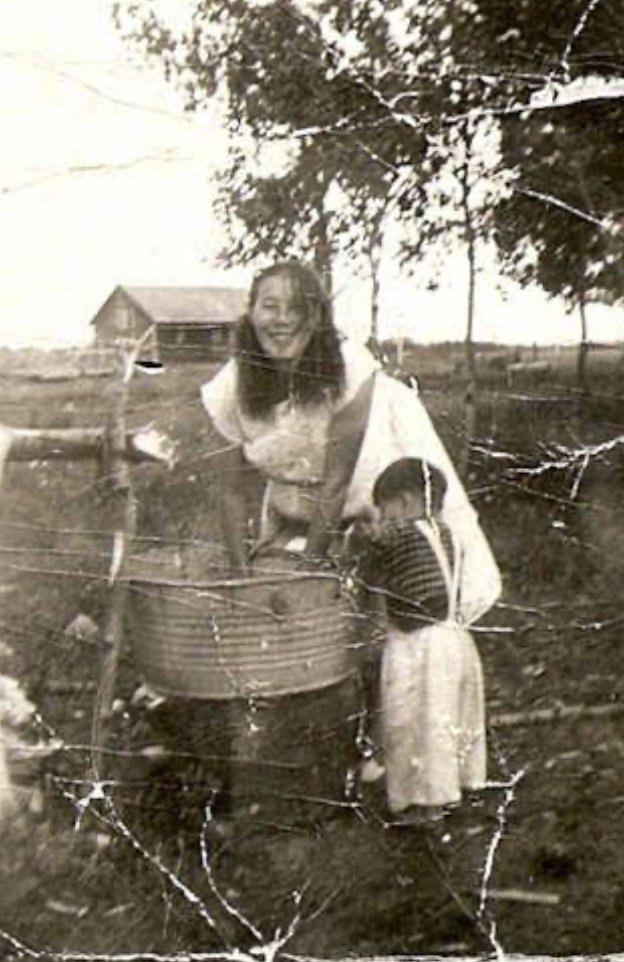Bill 54 Has No Claim to Our Memory
"Nitatamihk, nîhiyaw nikîsikâw nîkihkânak kîsikâw wâhkôhtowin,
ekwa nânitaw nikîsikâw nîkihkânak kîsikâw wâhkôhtowin."
"With gratitude, I honour my family for passing down our kinship laws,
and I thank them for making this moment possible."
When some people speak of “Alberta”, they begin the story in 1905 – the year Canada drew a provincial line across these lands. But for many of us, the story starts long before confederation.
My chapans – my great-grandparents – were already here, raising families and living in deep relationship with the land now colonially known as Alberta. Just three generations back, they lived and cared for this place, not as newcomers, but as part of long-standing kinship systems.
In Photo: Left to Right: Joan Bourque - Maternal Aunt, Nancy Cardinal - Maternal Great-Grandmother, Victoria Huppie-Bourque - Maternal Grandmother
Nancy Cardinal born in 1881 at Elk Lake, now known as Lac La Biche, Alberta, Adolphine Huppie (born in 1879 at the same place), William Lewis (born in 1884 in South Dakota), and Mary Bertha King dit Roy (born in 1901 in Montana) show that family, culture, and Indigenous sovereignty flowed freely long before these borders existed.
In photo: Left to Right - William Lewis, Mary Bertha King dit Roy
These names aren’t just entries in a family tree. They are memory. They are evidence. They are living proof that our experiences – and our rights – preexist so-called Alberta.
What did our families hold before so-called Alberta?
Sprawling settlements, permanent log homes with glass windows, parlours, livestock and gardens, not tents and shacks.
They owned Red River carts, horses, and oxen, moving goods across vast trade routes from St. Albert to Fort Edmonton to Batoche.
They held legal land titles in places like Lac La Biche, Conklin, St. Albert, St. Paul des Métis, Fort Saskatchewan, Lesser Slave Lake, Beaver River, Athabasca, Lac Ste. Anne, Cold Lake, and Fort Edmonton.
As fur traders, hunters, interpreters, and farmers, they powered the regional economy long before Canadian institutions arrived.
They were fluent in Cree, French, English, and Michif—moving seamlessly between cultures and acting as bridges between worlds.
Their names are found in buffalo hunting brigades, church records, community governance, and international trade routes that reached into Montana and South Dakota.
They participated in military-style political systems, such as the buffalo hunt councils and resistance networks led by leaders like Gabriel Dumont, to whom they were directly connected by blood and alliance.
They governed through kinship and ceremony.
They built cross-border trade and political networks.
We were not waiting to be claimed by colonial nations — or their legislation.
My maternal line — the Bourques, Huppies, Cardinals, Archambaults, Cyrs, Desjarlais’, Decoines, and Ladouceurs — were part of a fully formed Métis society long before the British Crown claimed land. They were landowners, healers, spiritual leaders, and educators who lived in organized communities with wealth, law, and identity.
My mother, Frieda was born into a lineage of women who never bowed their heads — women who knew ceremony, kinship law, and land. She carries teachings not only from matriarchs who raised children in road allowance communities, but whose spirits came from homesteads and river lots taken by force.
In Photo: Frieda Bourque - My Mother
Maternal Lineages
The Bourques
Land-rich, politically aware, and deeply connected to trade routes across Lac La Biche, Battle River, and Fort Edmonton, the Bourques were providers, defenders, and fur trade veterans. They stood for self-reliance and cultural pride, even as settler laws tried to write them out.
In Photo: Victoria Huppie, Patrick Bourque - Maternal Grandparents
The Huppies
Connected to Red River governance and St. Boniface landholders, the Huppie line carried forward land-based Métis legal knowledge and spiritual authority. They raised families that thrived through kinship, and collective discipline.
The Cardinals
One of the most prominent Cree-Métis families on this land, the Cardinals were known for their roles as interpreters, healers, and knowledge keepers. They protected land not with weapons, but with law, and presence.
In Photo: Joan Cardinal-Huppie-Bourque, - Maternal Aunt
The Ladouceurs and Desjarlais
They were nation-builders, fur trade veterans, and cultural stewards. In 1836, Joseph “Mitche Cote” Desjarlais established Fort Desjarlais near Lac La Biche – a key trading post that anchored Métis presence in the region. Known for their roles in protecting land and preserving ceremonies, they stood at the front lines of cultural survival and political resistance. Rooted in the Beaver River trading corridor, the Ladouceurs were connected to early Métis mobility, the buffalo economy, and resistance to displacement. They knew the land and how to move through it when escape or protection was needed.
The Archambaults, Cyrs and Decoines
This diplomatic and trade-based family lineage played a powerful role in fur trade negotiations, marriage alliances, and cultural leadership. They were known as people who could speak to many worlds at once — Cree, French, and Métis. These Red River matriarchal lines brought strength and vision to the fur trade economy. They were also builders of kinship networks, carriers of Nehiyaw (Cree) and French worldviews, and leaders in the survival of cross-border Métis families.
This claim doesn’t begin – or end – with one side. My mother’s families and my father’s families both carried strength, knowledge and resistance that define who we are.
My paternal lineage — woven through the Blyans (Blandion), Bernards, Dumonts, L’Hirondelles, Gladues, King dit Roy, Dumais dit Dumas, Ayatchihaws, and the Lewis Family — forms a rich tapestry of Indigenous continuity and strength. These families lived with more wealth, organization, and education than many of the settlers who arrived to claim their lands and resources.
My father, Peter, is the descendant of a proud and unbroken line — raised in the spirit of resistance, community honour, and quiet pride. He carried the legacy of those who had led buffalo hunts, spoken across four languages, and governed through kinship law and collective discipline that placed him within the web of Red River assertion and Métis law.
In Photo: Left to Right - Frieda Bourque, Peter Blyan - Jamie Bourque-Blyan (me)
Paternal Lineages
The Blyan (Blandion) family
Descendants of Antoine Blondion, brother to Chief Big Bear, the Blandion/Blyans were land-defenders and protectors, tied to the buffalo trails and to political resistance. They stood their ground at Battle River and Paintearth, establishing homes and raising families with both Métis and Cree values of wahkohtowin (kinship).
In Photo: Tommy Blyan - Paternal Grandpa
The Bernards and Gladues
Entrepreneurial and community-minded, these families helped build St. Albert, known then as Big Lake, a vibrant flourishing river lot town — modeled after Red River. The Gladue matriarchs, including Justine Gladue, were cultural knowledge keepers, providers, and organizers. Their names appear in fur trade ledgers, mission logs, and oral memory as symbols of strength.
In Photo: Left to Right - Joe Blyan, Millie Lindsay, Oliver Blyan, Melanie Bernard, Louie Blyan, Sophie Stick
The Ayatchihaw Family
The Ayatchihaws were not settlers on this land — they were the land. They lived in populous, self-sustaining Nehiyawak confederacies with their own systems of governance, ceremony, and teachings rooted in science, and intergenerational knowledge.
They were buffalo hunters, caretakers of sacred relationships with the plant nations, carriers of songs, and ceremonial law. Their way of life was sophisticated, and deeply ethical — grounded in reciprocity, not extraction.
The Dumonts and L’Hirondelles
Central to the leadership of the Métis Nation — a family of buffalo generals, political organizers, and military strategists. Far from fringe figures, they were core nation-builders in the Métis fight for sovereignty and self-determination.
The King dit Roy, Dumais dit Dumas, and Lewis families
Born from Red River’s oldest lineages, these families preserved language, ceremonial law, and land-based governance. The women came from Winnipeg and St. François Xavier, communities where our matriarchs held land, wrote laws, and lived as free leaders of our nation. They held space on both sides of colonial lines, remembering the time when borders meant nothing to the people who belonged to the land.
In Photo: Left to Right - Elene A. Lewis - Paternal Grandmother, Peter Blyan - My Father
Our ancestors weren’t wandering — They lived in structured, land-based kinship, not waiting to become civilized — they already were.
The Canadian state viewed Métis wealth, literacy, and independence as a threat.
They weaponized scrip, militia violence, and racist land policies to remove us.
Métis homes were burned, and lands seized — while colonial laws labelled us as “squatters” on their own homesteads.
We proudly joined the North-West Resistance – and for that, we were made enemies. Our very survival was criminalized. We were pushed onto road allowances as punishment for asserting our rights.
Our rights were violated then — and they continue to be violated today.
Even without colonial recognition, we have always held inherent rights. But today, those rights are acknowledged and codified in both international and national law. Bill 54, and others like it, violate them.
United Declaration on the Rights of Indigenous Peoples (UNDRIP ) Article 26 affirms our right to own, use, develop, and control our traditional lands, territories, and resources.
United Declaration on the Rights of Indigenous Peoples (UNDRIP) Article 28 guarantees our right to redress and restitution for lands and resources taken without free, prior, and informed consent.
Truth and Reconciliation Commission Call to Action #45 recognizes the historic legal and political exclusion of Métis peoples and calls on governments to advance justice and reconciliation.
These are not symbolic aspirations — they are legal and moral obligations.
And so-called Alberta cannot legislate them away.
The passing of Alberta’s Bill 54 is a direct threat to the self-determination, land rights, and living memory of Indigenous Nations.
It does not speak for the descendants of landholders, resistance leaders, or knowledge keepers. It holds no legitimate claim over our identity, our laws, or our homelands.
Only three generations ago – before the colonial invention of Alberta, there were the Bourques, Blyans (Blandion), Huppies, Cardinals, Archambaults, Cyrs, Desjarlais’, Decoines, and Ladouceurs —, Bernards, Dumonts, L’Hirondelles, Gladues, King dit Roy, Dumais dit Dumas, Ayatchihaws and the Lewis Family.
And countless other Indigenous families.
These were not scattered bands — they were Nations, and we’re still here.
Nations with governance, language, spirituality, and land title — grounded in law older than so-called Alberta.
We stand with our families, our First Nations relatives across Treaty 6, Treaty 7, and Treaty 8 territories — Nations who continue to defend the lands, waters, treaties, and laws that colonial governments have spent generations trying to erase.
We reject all actions that seek to divide, silence, or erase the truths of who we are — because our very existence calls into question the legitimacy of colonial claims to this land.
We remember what they want forgotten:
That we were sovereign, self-sufficient, and united long before so-called Alberta — and we still are.
Learn about Bill 54
Preliminary Analysis of Bill 54: Election Statutes Amendment Act, 2025
Central Alberta First Nations slam Bill 54
Cold Lake First Nations opposes Alberta's proposed Bill 54
First Nations unity displayed at rally against Alberta separatism
Calls to Action
1. Attend Rallies and Demonstrations
First Nations communities have organized rallies against Bill 54. For instance, hundreds of First Nations people rallied outside the Alberta legislature in opposition to the bill, which lowers the threshold needed to initiate referendums, including those on provincial separation from Canada. Participating in such events can amplify collective voices and show solidarity. (Global News+4YouTube+4Red Deer Advocate+4)
2. Contact Your MLA
Reach out to your Member of the Legislative Assembly (MLA) to express your concerns about Bill 54. Sharing informative resources, like the breakdown of Bill 54 by Jared Wesley, can help inform your MLA and advocate for reconsideration of the bill. (Facebook)
3. Engage on Social Media
Use platforms like Facebook, Twitter, and Instagram to share information, personal stories, and updates related to Bill 54. Engaging with content, such as the Instagram reel discussing the minister's response to questions about Bill 54, can help spread awareness and mobilize others. (Instagram)
4. Support Indigenous Leadership
Organizations like the Confederacy of Treaty 6 First Nations and Cold Lake First Nations have publicly opposed Bill 54, stating that it threatens treaty rights and sovereignty. Supporting these organizations through donations, attending their events, or amplifying their messages can strengthen the opposition.
5. Stay Informed and Educate Others
Acknowledge the impact of settler presence on these lands — felt deeply in just three generations. Keeping yourself and others informed about the implications of Bill 54 is crucial. Discuss the bill's potential impacts with friends, family, and community members to foster a broader understanding and collective action. (Gathering to Commemorate and Celebrate the 55th Anniversary of the Red Paper)
6. Enact Your Kinship Laws
We call on all Indigenous families to enact your own kinship laws—not just in spirit, but in visible, documented ways. Create your family breakdowns. Trace your ancestral presence to the land. Gather the names, birthplaces, stories, and movements of your great grandparents and their children.
This isn’t just genealogy—it’s land evidence.
It’s memory.
It’s law.
And it’s resistance.
In the face of legislation like Bill 54, our kinship systems are more than cultural—they are jurisdictional.
About the author
A citizen of the Buffalo Lake Métis Settlement, where he was raised among his grandparents and large extended family, Jamie is a parent, filmmaker and has been part of the Indigenous Climate Action team for three years. His work outside of ICA explores truth, memory, and Indigenous resurgence. With deep roots in the Métis homeland, he carries forward stories and experiences passed down through generations — grounded in kinship, resistance, and relationships.










